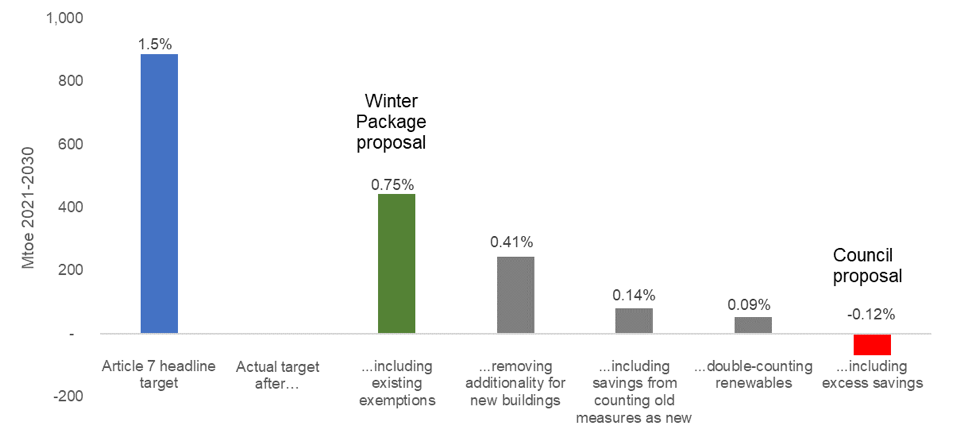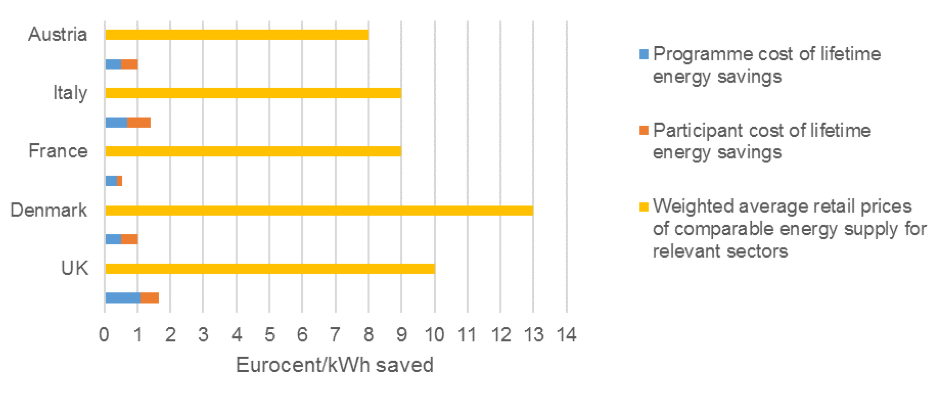Saving energy saves money, improves security, lowers emissions, and makes it easier to meet renewable energy and climate goals. That’s why energy efficiency is the sensible foundation for the Energy Union and the 2030 Clean Energy Package now under review: deeper savings make the rest of the goals so much easier to achieve. They will also generate considerable additional social, economic and health benefits. It is shocking, then, to learn that amendments now being considered in the European Council could weaken that foundation to the point of collapse.
In November last year, the European Commission’s Clean Energy Package proposed a 30 percent energy efficiency target for 2030. Given that the EU is on track to achieve 24 percent savings by 2030, and that deeper savings are both widely available and cost-effective, experts noted that saving just 6 percent more is a very modest goal. This is why the European Parliament called for a 40 percent target in June last year. There was an expectation that the compromise reached might end up somewhere between 30 percent and 40 percent.
Going backwards on energy efficiency
This was, as it turns out, wishful thinking, at least in this Council. Several Member States are pushing for even weaker targets. A vote on this is expected for next Monday. In particular, proposals are being prepared to water down the provisions in Article 7 of the Energy Efficiency Directive (EED), which delivers about half of the entire savings of the Directive and is a key driver for energy efficiency in Europe.
Current proposals circulated in the European Council introduce a range of new loopholes:
- Double counting all energy savings from new buildings standards/codes even though those are covered by the Energy Performance in Buildings Directive already;
- Double counting savings towards the period 2021-2030 from energy efficiency measures installed before 2021 with lifetimes longer than 23 years as if they were new savings;
- Allowing 15 percent of on-site renewable energy generation to be treated as energy savings; and
- Allowing excess savings from the current Article 7 period 2014-2020 to lower the minimum savings 2021-2030.
As is often the case with legislative loopholes, their impacts are not immediately obvious, but an informed review reveals that they will greatly weaken key features of the EED.
If accepted, those proposals will reduce the current ambition levels by more than 80 percent and perhaps as much as 100 percent depending on the amount of excess savings and how Member States apply these proposed terms. The figure below summarises the impact of introducing the proposed new loopholes.
Proposals reduce ambition levels by 80 to 100 percent

Source: RAP analysis based on EC (2016a), EC (2016b), Ricardo et al. (2016), and data from Buildings Observatory. Mtoe = million tons of oil equivalent
As this simple review reveals, the amendments being considered in the Council (excluding excess savings) will reduce the actual energy savings mandate in the EED from an effective level of 443 Mtoe per year to just 52 Mtoe—a reduction of almost 90 percent. Depending on the amount of excess savings reported by Member States in 2014 and 2015 the total savings target is currently on track to be less than 0 Mtoe.
Even a very optimistic estimate suggests a reduction of the current ambition level by around 80 percent to 92 Mtoe. This assumes very little excess savings, only a small amount of renewable energy being counted, and more efficient new buildings in the absence of building codes than assumed.
This flies in the face of the impact assessment by the European Commission which shows that more ambitious efficiency targets deliver greater benefits for consumers and the economy. Such diluted energy efficiency targets will raise energy bills, raise energy imports, and raise the cost of meeting the commitments that Europe has made to the world in Paris.
Long-term ambitious targets needed to provide investor confidence
Ambitious and firm targets are important for investors. More than 400 individuals attended the Energy Efficiency Finance Market Place conference that took place in Brussels in January, including major banks, pension funds and insurance companies. There was unanimous agreement that lack of capital is no barrier to more energy efficiency. To the contrary, speakers agreed that there are substantial amounts of capital well-suited for investment in energy efficiency. The most important point from the perspective of financiers was a long-term stable policy framework for energy efficiency. This includes an ambitious energy efficiency target and a continuation of Article 7 at least at 1.5 percent.
Consumers reap the benefits from strong energy efficiency policies
Consumers benefit directly from effective energy efficiency policies. This is because the cost of saving energy is far below the cost of consuming it. The most comprehensive data on the investment requirements of measures promoted by Article 7 of the Energy Efficiency Directive can be found for energy efficiency obligations (EEOs), the instruments that provide the largest share of the savings. A review of all EEOs in Europe where data exists demonstrates high cost-effectiveness.
In the case of all five EEOs analysed, the data clearly show that the cost of negawatt-hours is much lower than that of megawatt-hours. Even if the contributions from those who benefit from the programme to the investment cost of efficiency measures are added (which is typically about one to two times as much as the programme cost), the cost per kWh even in the most “expensive” programme is just below 3 eurocents/kWh. This compares to an average cost of supplied energy of 10 eurocents/kWh.
Energy Efficiency Costs Less Than Supplied Energy

Source: Rosenow and Bayer (2017)
Data for alternative measures such as loans, tax rebates, and grants shows that the programme costs of those measures are of a similar scale, although somewhat higher. On average, saving 1 kWh through those measures has a public cost of 1.4 eurocents/kWh.
Can we be confident that this data is reliable? We can: It is in line with the most recent data from the De-Risking Energy Efficiency Platform (DEEP) database, which contains close to 6,000 individual energy efficiency projects across the Member States of the EU. Overall, the costs per kWh saved in buildings are 2.5 eurocents and in the industry sector 1.2 eurocents.
Power system savings benefit all customers
Lowering demand at the customer end of the power system lowers costs at every link in the power system. These benefits, often overlooked in Europe, include avoided transmission and distribution costs, avoided line losses, and minimisation of reserve requirements. In competitive power markets, lower demand also means lower clearing prices for power, which reduces per-kwh charges for all customers. A recent study exploring the scale of system benefits in Europe affirms what international experience has demonstrated for a long time—comprehensive, long-term, and aggressive investment in end-use energy efficiency will yield substantial energy system cost savings. The value of electricity savings in Germany to the power system alone is in the range of 0.11–0.15 eurocents per kilowatt-hour saved.
End use efficiency also has the benefit of being available exactly when it is needed. Unlike power generation, which must be managed to line up with energy demand, efficiency is automatically “on” whenever the lights are on, or the motors are turning—provided of course, that we have bothered to ensure that the equipment was efficient in the first place.
Efficiency delivers multiple, wide-ranging benefits
In addition to bill savings and system cost savings (the most obvious benefits of energy efficiency improvements), energy efficiency delivers a wide range of so-called “non-energy” benefits to consumers and society. Amongst those are improvements in health, comfort, air quality, public housing and welfare costs, job creation, and economic growth. Energy efficiency (and the resulting demand reduction) also delivers substantial environmental benefits in terms of CO2 mitigation.
Efficiency provides the foundation for the Clean Energy package
Decades of experience across more than 50 nations, states, and provinces reveals that disciplined energy efficiency programs like those created under the EED are the lowest-cost, most widely-available, and most reliable way to reduce CO2 emissions while we build the new energy systems needed in a low-carbon economy. But energy companies don’t naturally invest in efficiency, and efficiency programs do not spring into being on their own—governmental support is required. That is why the EED is so important. Europe’s entire Clean Energy package will be less expensive, more reliable, and easier to achieve if it begins with a strong foundation of energy savings. Undermining that foundation with weak savings targets in the EED is a major backwards step for the European Union.
A version of this blog was originally published by Energy Post.


